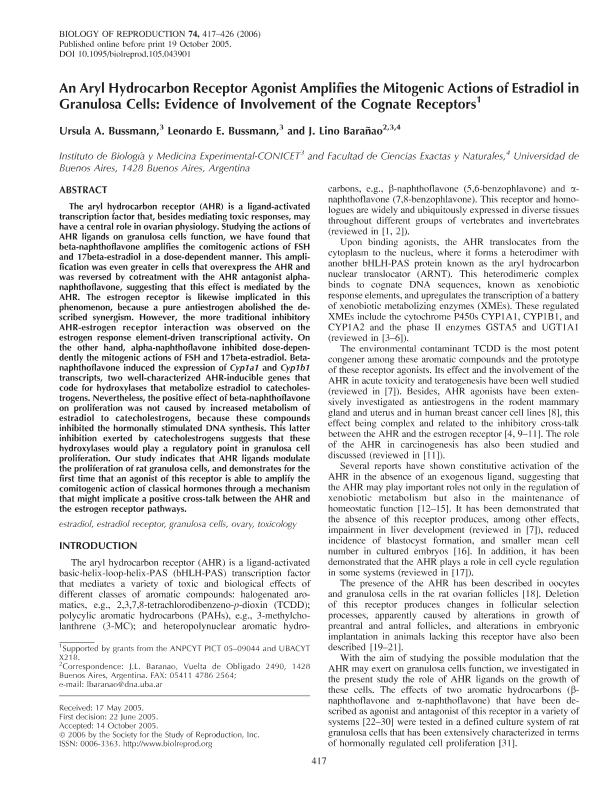Mostrar el registro sencillo del ítem
dc.contributor.author
Bussmann, Ursula Agnes

dc.contributor.author
Bussmann, Leonardo Edmundo

dc.contributor.author
Barañao, Jose Lino Salvador

dc.date.available
2017-11-18T12:00:07Z
dc.date.issued
2006-02
dc.identifier.citation
Bussmann, Ursula Agnes; Bussmann, Leonardo Edmundo; Barañao, Jose Lino Salvador; An aryl hydrocarbon receptor agonist amplifies the mitogenic actions of estradiol in granulosa cells: evidence of involvement of the cognate receptors; Society for the Study of Reproduction; Biology of Reproduction; 74; 2; 2-2006; 417-426
dc.identifier.issn
0006-3363
dc.identifier.uri
http://hdl.handle.net/11336/28534
dc.description.abstract
The aryl hydrocarbon receptor (AHR) is a ligand-activated transcription factor that, besides mediating toxic responses, may have a central role in ovarian physiology. Studying the actions of AHR ligands on granulosa cells function, we have found that beta-naphthoflavone amplifies the comitogenic actions of FSH and 17beta-estradiol in a dose-dependent manner. This amplification was even greater in cells that overexpress the AHR and was reversed by cotreatment with the AHR antagonist alpha-naphthoflavone, suggesting that this effect is mediated by the AHR. The estrogen receptor is likewise implicated in this phenomenon, because a pure antiestrogen abolished the described synergism. However, the more traditional inhibitory AHR-estrogen receptor interaction was observed on the estrogen response element-driven transcriptional activity. On the other hand, alpha-naphthoflavone inhibited dose-dependently the mitogenic actions of FSH and 17beta-estradiol. Beta-naphthoflavone induced the expression of Cyp1a1 and Cyp1b1 transcripts, two well-characterized AHR-inducible genes that code for hydroxylases that metabolize estradiol to catecholestrogens. Nevertheless, the positive effect of beta-naphthoflavone on proliferation was not caused by increased metabolism of estradiol to catecholestrogens, because these compounds inhibited the hormonally stimulated DNA synthesis. This latter inhibition exerted by catecholestrogens suggests that these hydroxylases would play a regulatory point in granulosa cell proliferation. Our study indicates that AHR ligands modulate the proliferation of rat granulosa cells, and demonstrates for the first time that an agonist of this receptor is able to amplify the comitogenic action of classical hormones through a mechanism that might implicate a positive cross-talk between the AHR and the estrogen receptor pathways.
dc.format
application/pdf
dc.language.iso
eng
dc.publisher
Society for the Study of Reproduction

dc.rights
info:eu-repo/semantics/openAccess
dc.rights.uri
https://creativecommons.org/licenses/by-nc-sa/2.5/ar/
dc.subject
Aryl Hydrocarbon Receptor
dc.subject
Estradiol
dc.subject
Estradiol Receptor
dc.subject
Granulosa Cells
dc.subject
Ovary
dc.subject
Toxicology
dc.subject.classification
Biología Reproductiva

dc.subject.classification
Ciencias Biológicas

dc.subject.classification
CIENCIAS NATURALES Y EXACTAS

dc.subject.classification
Bioquímica y Biología Molecular

dc.subject.classification
Ciencias Biológicas

dc.subject.classification
CIENCIAS NATURALES Y EXACTAS

dc.title
An aryl hydrocarbon receptor agonist amplifies the mitogenic actions of estradiol in granulosa cells: evidence of involvement of the cognate receptors
dc.type
info:eu-repo/semantics/article
dc.type
info:ar-repo/semantics/artículo
dc.type
info:eu-repo/semantics/publishedVersion
dc.date.updated
2017-10-26T14:40:22Z
dc.journal.volume
74
dc.journal.number
2
dc.journal.pagination
417-426
dc.journal.pais
Estados Unidos

dc.description.fil
Fil: Bussmann, Ursula Agnes. Consejo Nacional de Investigaciones Científicas y Técnicas. Instituto de Biología y Medicina Experimental. Fundación de Instituto de Biología y Medicina Experimental. Instituto de Biología y Medicina Experimental; Argentina
dc.description.fil
Fil: Bussmann, Leonardo Edmundo. Consejo Nacional de Investigaciones Científicas y Técnicas. Instituto de Biología y Medicina Experimental. Fundación de Instituto de Biología y Medicina Experimental. Instituto de Biología y Medicina Experimental; Argentina
dc.description.fil
Fil: Barañao, Jose Lino Salvador. Consejo Nacional de Investigaciones Científicas y Técnicas. Instituto de Biología y Medicina Experimental. Fundación de Instituto de Biología y Medicina Experimental. Instituto de Biología y Medicina Experimental; Argentina. Universidad de Buenos Aires. Facultad de Ciencias Exactas y Naturales; Argentina
dc.journal.title
Biology of Reproduction

dc.relation.alternativeid
info:eu-repo/semantics/altIdentifier/url/https://academic.oup.com/biolreprod/article/74/2/417/2667045
dc.relation.alternativeid
info:eu-repo/semantics/altIdentifier/doi/http://dx.doi.org/10.1095/biolreprod.105.043901
dc.relation.alternativeid
info:eu-repo/semantics/altIdentifier/url/http://europepmc.org/abstract/med/16237154
dc.relation.alternativeid
info:eu-repo/semantics/altIdentifier/pmid/16237154
Archivos asociados
